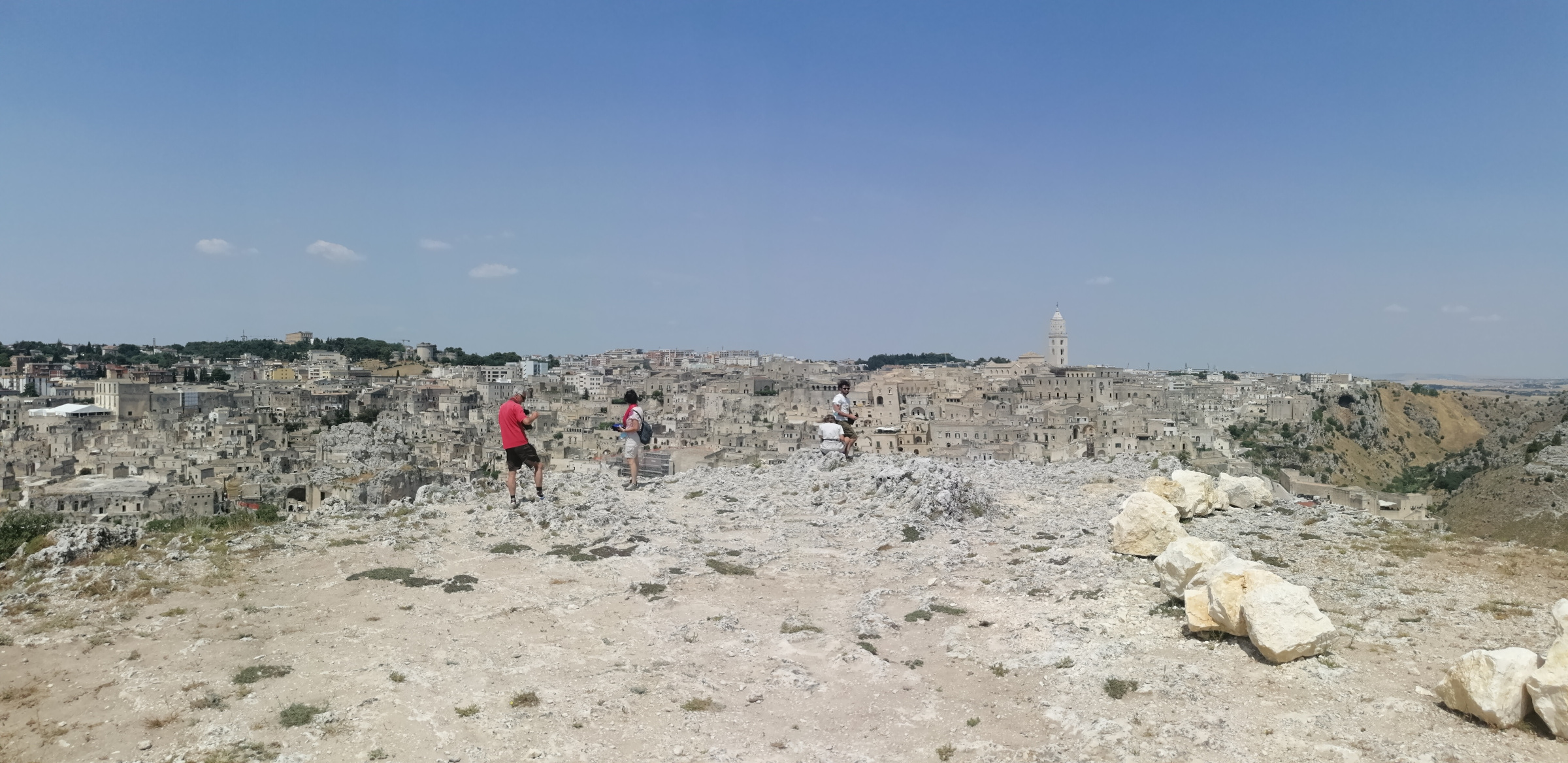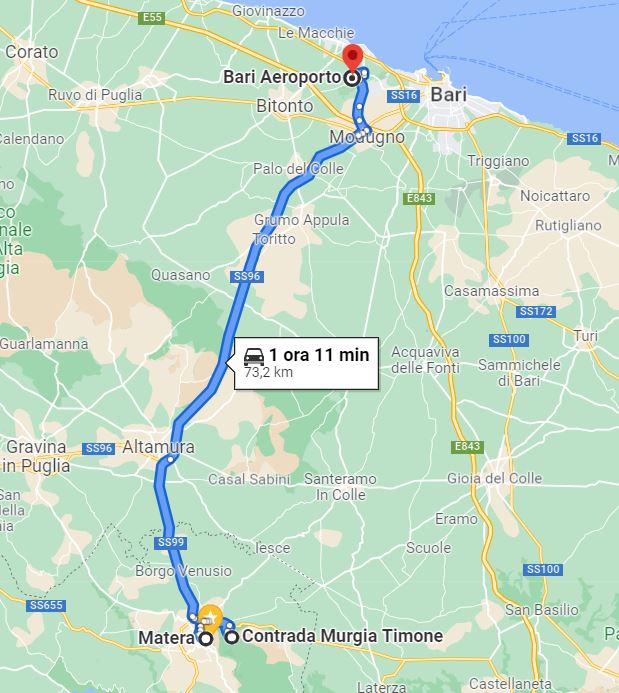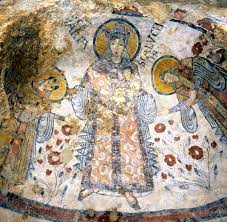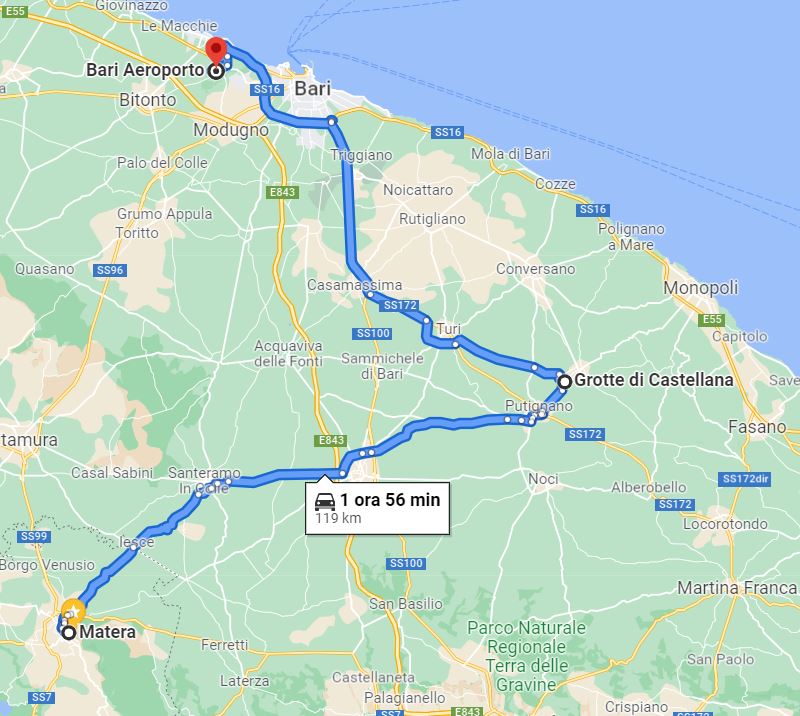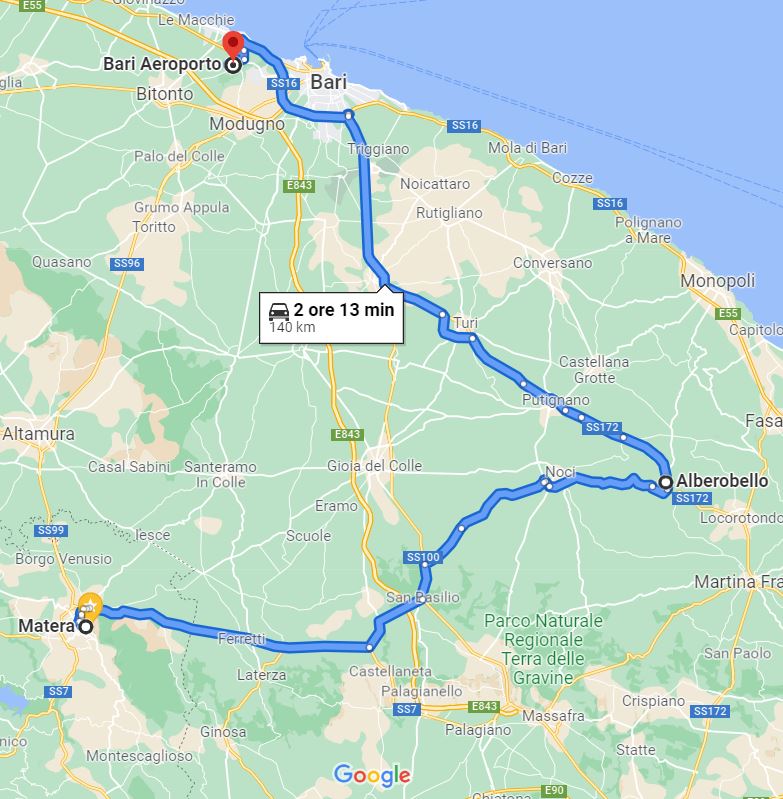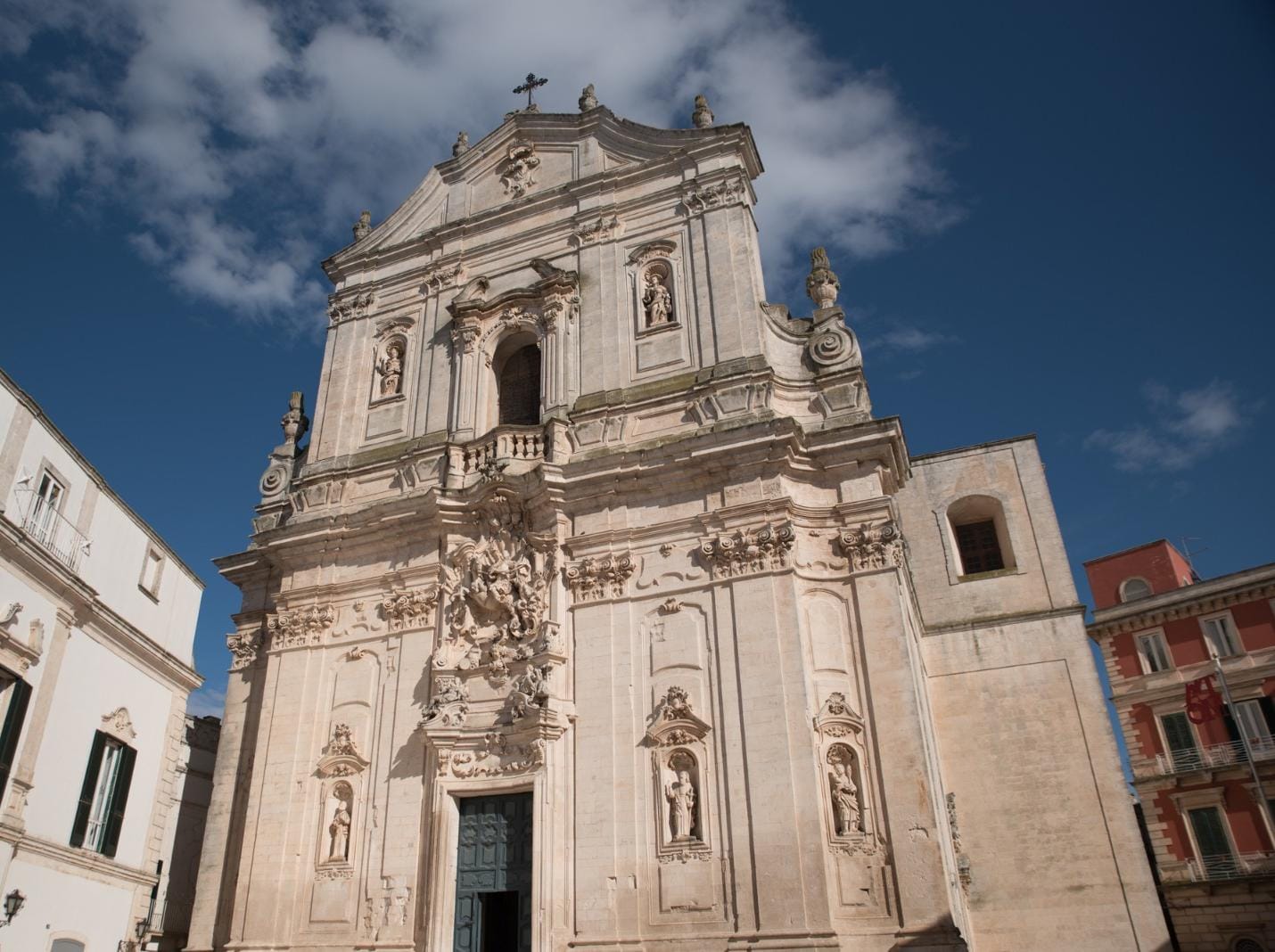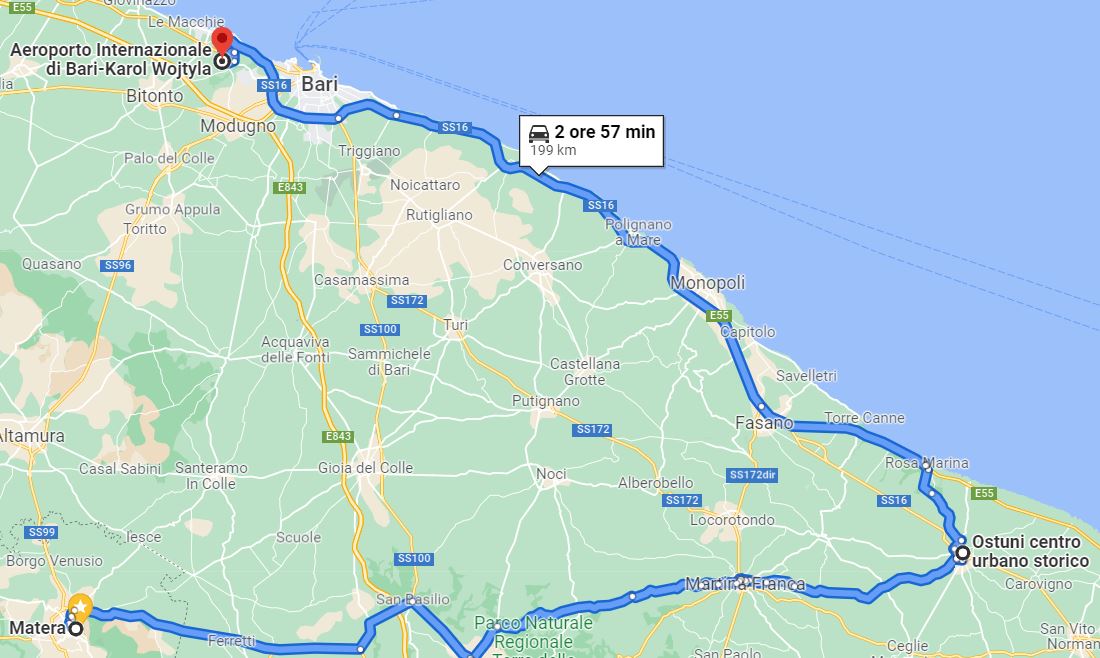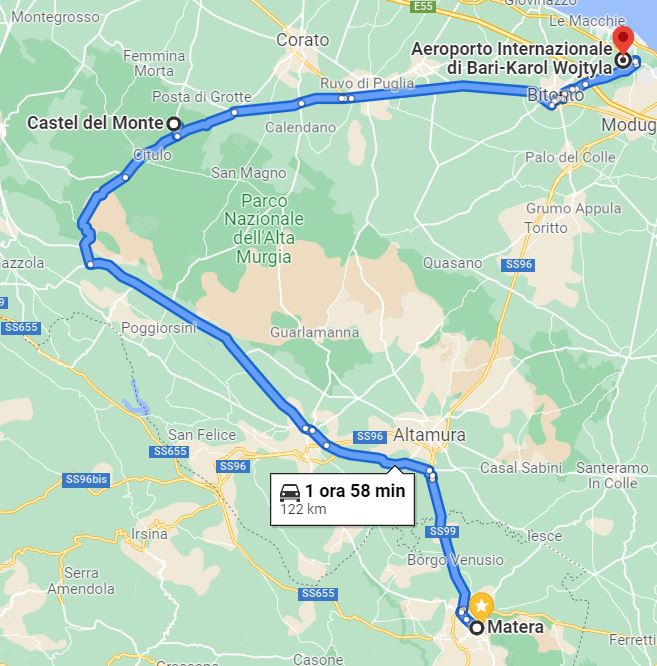RENTAL SERVICES WITH DRIVER
FROM AND TO MATERA
RATES
Matera | Bari airport shared service
Shuttle Matera
by Made in South of Italy
| number of passengers | fare * without sharing** |
| 1/2 pass. | € 80.00 |
| 3 pass. | € 90.00 |
| 4 pass. | € 100.00 |
| 5 pass. | € 110.00 |
| 6 pass. | € 120.00 |
| 7 pass. | € 130.00 |
| 8 pass. | € 130.00 |
| ** discount with sharing | |
| within 30 minutes | -10 |
| over 30 minutesi | -20 |
* total fare for number of passengers, excluding VAT 10%
Please note!
The above rates are valid for companies with us directly affiliated and confirmed at the time of booking. In case our cars of partner companies are not available, other solutions will be proposed and agreed and, in this case, rates may vary.
time slot
from 7:00 (car departure time from Matera)
to 21:00 (arrival time car in Matera)
from 21:00 to 7:00 check additional charges
additonal charges
Bari city, station or port + € 10,00
working days outside the time slot + € 10,00
Sunday surcharge +€ 10,00
festive surcharge +30%
driver available for the first 3 hours + € 25,00/h
driver at disposal from the fourth hour + € 30,00/h
Our fares include
passenger insurance;
car rental with driver;
fuel cost;
driver waiting in case of flight or train delay.
Our fares do not include
TAX 10%;
Motorway tolls, car parks or ferry tickets;
Meals and overnight stays for full day driver;
everything not expressly indicated in "the rates include"
IMPORTANT!
in all cases where it is impossible to reach the desired places or make transfers due to problems not arising from our will (such as unusable road surfaces, snow, dangerous situations, etc.) Shuttle snc reserves the right NOT TO CARRY OUT the transfer in the times and places previously booked and to agree on the cancellation or variation of the transfer methods, as well as the rates, days and times of departure or meeting.
Possible excursions in addition to the service
from Matera to Bari airport or vice versa
Belvedere (Murgia Timone)
Murgia Timone, together with Murgecchia, is a plateau located in front of the heart of the Sassi and the oldest part called "La Civita" just past the river Gravina. The whole surrounding area is characterized by the presence of caves well visible from the ancient tufa districts. In this area was discovered the first entrenched village. The discovery is attributed to the peasant materano Giovanni Iacovuzzi, one of the most valuable collaborators of Ridola.
The neolithic village
The village has an almost oval shape and gathers more Neolithic huts. In the outer part of this village there is a moat, defined by Ridola a "Trench", excavated most likely with stone tools. This moat has a width between 1.90 and 2.70 meters in width and a depth between 1.50 and 2.50 meters for a total perimeter of the moat is 664 meters. Within it were found by Ridola numerous holes that are thought to be used for the installation of wooden poles for the huts. Graves have also been found in grotticella hypogea, obviously after the occupation of the site.
The archaoligic findings
In the site were also found several objects dating back to the prehistoric age and especially processed stones. In addition to these carved stones were later brought to light numerous other archaeological finds such as fragments of painted vases, three axes in polished stone (typical of the Neolithic), bone spatulas and blades. These objects are currently the numerous preserved in the National Archaeological Museum "Domenico Ridola" of Matera.
Crypt of Original Sin
On Via Appia towards Miglionico at Km 567, after crossing the bridge over the Gravina torrent, take the first tract on the right and follow it in full. A narrow and uneven staircase leads to the rooms below where the rock church "of Original Sin" more known as "the Cave of the Hundred Saints". The interior of the crypt, vaguely rectangular, has only the left wall moved by three large unequal niches.
This cave, poor in architectural elements, is characterized by a remarkable pictorial cycle that illuminates the interior walls of the left and bottom. The back wall is divided by the erect figure of Christ the Redeemer who wrote the letters in the three sectors of the nimbus cross : P A X. To his left develops the biblical episode of "Original Sin". The scenes that unfold on the other half of the wall recall the advent of Darkness (evil) and Light (good). Below is the liturgical purification of a bishop.
On the left wall the three apse niches contain as many triarchies. The first presents S. Peter flanked by S. Andrea and S. Giovanni. The second Triarchy shows the Madonna and Child adored by two Muliebri figures. The third composition represents the Triarchy of the Archangels. The flat wall above the three apses was also once decorated with wall paintings, now reduced to small illegible fragments. In the innermost area, very ruined, appears the Christ with the nimbus of the cross holding in the left a black globe. On the side, kneeling, is the Archangel Gabriel in the act of worship.
Altamura
There are 2 accesses to the historic center. Porta Matera and Porta Bari. The latter was part of the ancient city walls that surrounded the city. Today its current appearance is very different from the original. Passing through the Porta Bari, take the Corso Federico II of Svevia, to reach both the National Archaeological Museum and the Ethnographic Museum of Alta Murgia.
National Archaeological Museum
Inside you can visit:- the reproduction obtained from the remains of the Man of Altamura (christened Ciccillo);- the area reserved for the "Prehistory of food - The origins of bread", with a deepening on the evolution of food production processes from the Neolithic to today. - an in-depth study of the Paleolithic in Puglia and a good collection of finds from archaeological excavations in the area, particularly in the necropolis.
The man from Altamura
The real remains of the man of Altamura are kept in the not distant cave of Lamalunga. They belong to the oldest Neanderthal to which it was possible to read the DNA. A museum has been dedicated to the Man of Altamura in the five-seventeenth century Palazzo Baldassarre.
The Ethnographic Museum of Alta Murgia
Founded on the initiative of an archaeological collector and overseer Pietro Locapo. First entitled the Museum of Peasant Civilization. It houses and exhibits the collection of agricultural-pastoral life in the territory of Alta Murgia, between the late nineteenth century and the early decades of the twentieth century.
The Cathedral
The Cathedral of Santa Maria Assunta is the most important main monument Built in the thirteenth century by the will of Frederick II of Swabia, it is located in the street named after the same emperor. The monument of Piazza del Duomo. The main facade is enriched by decorations that surround the main portal.
In the architrave it is easy to recognize a representation of the Last Supper; and the scene of the Madonna enthroned with the child and two angels, depicted in the lunette. In the arches you can admire 22 scenes from the life of Jesus. Below, two lions stand guard. The interior, in baroque style, consists of polychrome marble, the coffered ceiling, the coats of arms of the reigning families. Inside it can be visited thanks to two side walkways.
Trani
The Historic Center
The Old Town of Trani is a very special place to spend a few pleasant hours or simply walk enjoying the beautiful views 2 steps from the sea or enjoy an aperitif among the locals. Crossing the historic center you finally get to the municipal villa that runs along the sea. For those who are interested in a more in-depth visit, Trani offers excellent ideas.
The port and the fort
Visiting Trani should not miss the port. Overlooking the port are also the Church of All Saints and Palazzo Caccetta. Nearby there is also the fort, an ancient building near the pier of Sant'Antonio, from which you can enjoy a privileged view of the city.
The Cathedral
Not far from the port, the cathedral of Santa Maria Assunta can be reached by a pleasant walk. It’s one of the most important buildings in Trani. It is a majestic building in Apulian Romanesque style, a stone’s throw from the sea, light pink tuff quarries of the interland. Its construction began in 1099 and was completed in 1200.
Noteworthy are the transept placed on the side towards the sea, the pointed arch under the bell tower and the staircase that allows access to the balcony on the facade, and then to the church itself. Inside the cathedral is divided into three naves. In the lower area there is the hypogeum of San Leucio, the ancient church of Santa Maria, and the crypt of San Nicola.
The castle of Trani
Not far from the Cathedral stands the Swabian Castle of Trani (1233). This castle was built by Frederick II of Swabia, The Castle was often home to the son of Frederick II, Manfred, who also celebrated his wedding here. The appearance of the fortress was modified several times during the various historical periods as it passed under the Angevin and then the Spanish domination.
The Jewish quarter
At the time of Frederick II Trani housed 4 synagogues that were later transformed into Catholic churches. Today, the Scolanova synagogue has returned to its ancient function, while another - the great synagogue - has been transformed into the museum of Sant'Anna.
Always remaining in the theme of Castles of Frederick II can be combined with this stage also Castel del Monte.
Polignano a Mare
Polignano a mare is the birthplace of the famous singer Domenico Modugno and just at one of the entrances there is a bronze statue dedicated to the singer, located on the seafront. Just behind the statue of Modugno, there is a staircase at the end of which leads to a flat rock surface that acts as a terrace; from here in fact you have a view of Cala Monachile, the cliff and the historic center with its white houses overlooking the sea.
Grotta Palazzese
Belonging to the palace of the Leto family, it is nothing but a cave in the rock overlooking the sea. Today it houses a renowned restaurant and is open only from Easter to October.
Marine caves
The entire coast around Polignano a Mare has over 70 sea caves. Today these caves can be visited by pedalo or boat. Boat trips to the caves last about two hours.
Poetry and the old town
One of the most interesting places of Polignano is its small historic center, which is accessed by passing under a marquesan arch called Arco della Porta. Walking through the various alleys you can notice the different styles of cultures such as Arabic, Byzantine, Spanish and Norman. Very interesting is the Palace of the clock, which is still loaded by hand by a lady. Continuing the wonderful walk in the old town you will feel wrapped in poetry. In fact, all the walls of the historic center are in fact paintings of poems.
Castellana Grotte
Le Grotte di Castellana
The Castellana grotte are a complex of underground caves of karst origin, just over 3 km long and at a maximum depth of 122 meters from the surface. They are located in the Itria Valley. These caves were discovered by Vincenzo Longo in 1938. Until then they were shrouded in mysteries and popular beliefs. Inside these caves of these caves develops a path between canyons, fossils, stalactites, stalagmites, concretions with incredible shapes and surprising colors stimulate the imagination of children and adults.
The origin of the Grotte di Castellana
The formation of the Castellana Caves begins about one hundred million years ago. During this period Apulia was submerged by an ancient sea in which lived several colonies of molluscs and marine vegetables. The various generations of these life forms had succeeded each other. Their empty shells and their carcasses had accumulated on the bottom of the sea. The progressive rise of the land had brought the region to its present appearance and in the limestone mass emerged, because of its rigidity, had formed extensive fractures that had strongly engraved. The eluvial water had formed an extensive underground aquifer that dissolved & nbsp; gradually limestone and enlarged fractures.
Alberobello
Alberobello, with its typical houses called Trulli, has been part of the UNESCO sites since 1996. Trulli are a type of construction with a conical shape roof of dry stone. Located in the Itria Valley, these buildings are the refinement of the prehistoric theolos, which are present in the various areas of Italy. What made the Trulli a World Heritage Site is their continued use.
The origins of the Trulli
Their origins date back to the fourteenth century. In that period that this land at the beginning uninhabited was assigned to the first Count of Conversano Andrea Matteo III Acquaviva d'Aragona, who delivered the lands to peasant families. With the passage of time they rose in the area of the rural settlements that, gradually coming together they formed real villages nicknamed later Aia Piccola and Monti. Due to the abundance in the limestone hinterland and to avoid paying taxes on new settlements to the Kingdom of Naples, new settlers were forced to build dry walls, without mortar, so that they could be easily dismantled.
Rione Monti
It’s composed of 1030 trulli. There are all kinds of trulli, the best known are the Siamese Trulli, united on the summit but with entrances that open onto two different roads. Once they were connected by an external door then, according to the legend, they were separated following a feud between two brothers, in love with the same girl. Many of the trulli in this area are home to small shops and craft shops where you can do some shopping. The Rione Monti can also be admired in its entirety from Piazza Gian Girolamo D'Acquaviva D'Aragona. In the center of Alberobello here is the roof terrace Belvedere also called Santa Lucia Terrace, made public to visitors in the '90s.
Rione Aia Piccola
Rione Aia Piccola is an area that includes 400 trulli, almost all inhabited. It is the area with less commercial activity perfect for "catapulting yourself" into the atmosphere of the old medieval village. In this area stands the Trullo Sovrano, a two-storey trullo with a huge today is a house-museum to admire the furnished rooms and the Mediterranean garden.
Other places to visit
In the center between Aia Piccola and Piazza del Popolo you can visit the museum Casa Pezzolla. It consists of 15 trulli communicating with each other headquarters of the Museum of the territory, to learn about the culture of the territory discovering the main productive activities of the area.
A little further from the old town, but easily accessible by a short walk, there is also the wine museum.
Martina Franca
It’s a beautiful town in Valle D'Itria in the province of Taranto. After a short trip surrounded by olive groves and vineyards you can easily reach the historic center of the city. The Baroque style that dominates the entire historic centre stands out right from the start.
The Basilica of San Martino
Walking pleasantly through the alleys of the old town you can immediately notice the Basilica of San Martino, built in the second half of the eighteenth century by the will of the archpriest Isidoro Chirulli. The Basilica is very suggestive and characterized by the typical white color of the marbles.
On one of the sides there is a representation of a scene symbolizing piety and brotherhood, in which the saint shares a cloak with a beggar. It is considered by many to be one of the most beautiful churches in southern Italy. Inside the church is rich in works of art by some local artists and houses the relics of the martyr Santa Comasia
The Beata Vergine del Carmine Church
In this Church stands out the polychrome statue of Stefano da Putignano preserved in it that depicts Santa Maria della Misericordia and is one of the greatest works of the Apulian artist, really remarkable..
The Sant'Antonio ai Cappuccini Church
This church, dating back to the sixteenth century, preserves inside the spectacular altars cabinet and among many, a fresco of the Madonna Odegitria, from which derives the name of the Valle d'Itria.
Palazzo Ducale
Continuing the walk you will come across the famous Ducal Palace. It was built by the will of Duke Petracone Caracciolo in the seventeenth century and today is the seat of the Town Hall. Inside there are beautiful temperas in the three halls of Arcadia, the myth and the Bible.
Palazzo Turnone
Another interesting palace is Palazzo Turnone, which today houses the Conservatory of Santa Maria della Misericordia which is also one of the oldest buildings in the city, dating back to the Angevin period, Its majesty is an expression of the power that the homonymous Martinese family exercised over the city.
Ostuni (the white city)
Ostuni is a beautiful city located in the area of Salento. Because of the traditional technique of whitening with lime milk the houses of the old town is called the White City. The area of tourist interest is undoubtedly the old part. To access the historic center you have to reach today’s Piazza della Libertà we find the Church of San Francesco da Assisi and the adjacent convent.
Piazza della libertà and the San Francesco Church
Both renovated, today the convent has been transformed into the extraordinary Palazzo San Francesco, seat of the Comunethe square, is often a place of meeting and theater of numerous events especially summer. Nearby you can see the Spire of Sant'Oronzo. In baroque stie it was realized by grace received after the escaped danger of the terrible plague that was scourging the entire kingdom of Naples.
From the square you can access the historic center through the two doors San Demetrio and Porta Nova. From here you go up, walking through the various alleys until you reach the top.
the historic center
Inside the historic center it is possible to admire the Gothic Cathedral, built in the second half of the 15th century in "docile stone" on commission of two sovereigns of the Kingdom of Naples, respectively Ferdinand of Aragon and Alfonso II. Its interior is entirely frescoed and you will notice the particularity of the apse slightly shifted to the left from the central nave.
This peculiarity was realized as a sign of devotion to Jesus who turned his head right to his left in His last breath. Still inside it is possible to admire the statue of the Saviour that points to his bloody side and shows the nail wound in his left hand. Still you can see the rose window symbolizing the Sun Christ
Vico Castello
Near the Cathedral you get to the so-called Vico Castello, so called to remember the presence of an ancient castle of 1148, built by Geoffrey III later largely demolished for later constructions.
Castel del Monte
The Castel
It’s a fortress built by Frederick II of Svevia in the 13th century. In 1966 Castel del Monte was included among the UNESCO World Heritage Sites. The building has an octagonal plan. Each corner is joined by an octagonal tower and enclose an inner courtyard also of octagonal shape. The interior space is divided into two floors, raised above the square in front. The rooms, of trapezoidal shape, are divided by walls that connect the edges of the inner octagon and the edges of the outer one.
In the rooms the covers were created by breaking down the initial trapeze into different sections. The central part has a square shape with a cross vault. As for the two triangles on the sides are dominated by two segments of barrel vault.
The castle consists of eight towers, on top of five of them there were cisterns, while the remaining three towers were used to house falconers and soldiers.Da ogni stanza fuoriesce una chiave di volta diversa. Il castello è composto da otto torri, in cima a cinque di esse vi erano delle cisterne, mentre le restanti tre torri servivano ad ospitare falconieri e soldati.
The origins of the Castel
Some theories hold that the castle could be a temple of knowledge for its forms derived from refined mathematical, geometric and astronomical knowledge. Other more recent hypotheses attribute its construction to the function of wellness center, suitable for regeneration and body care, on an Arabic model. Also the octagonal shape would suggest an idea to recall the shape of the crown.
For those who want a more in-depth visit there would be the possibility to rent a guide to meet directly at the entrance of the Castle.
Extra hours waiting driver
+20€ per hour of waiting
+25,00€ per hour and part of an hour
Our rental services with driver
Cartoline di Matera (postcards from Matera)
We collect splendid professional and amateur and vintage photographs of Matera and the Sassi. Browse our Facebook page and click "Like" for your favorite photos
